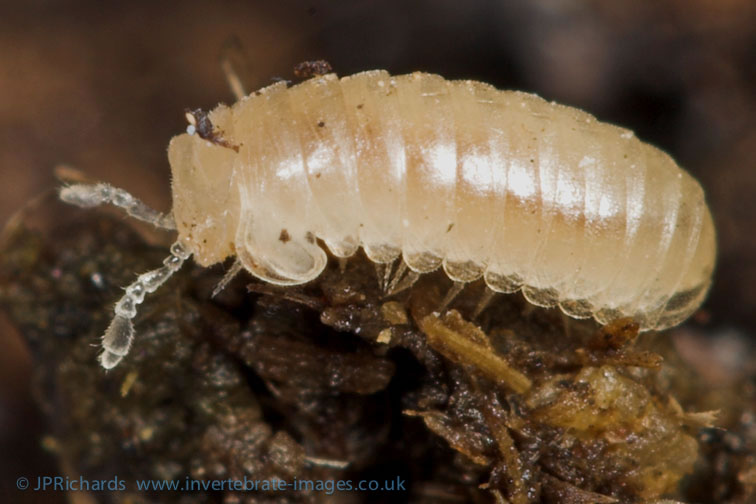Geoglomeris subterranea Verhoeff, 1908
Synonyms
- Geoglomeris jurassica Verhoeff, 1915
- Stygioglomeris crinata Brölemann, 1913
Status:
- GB IUCN status: Least Concern
- GB rarity status: Nationally Scarce
ID Difficulty
Identification
The pill millipedes, Glomeridae, are distinctive short stout millipedes that are able to roll into a defensive ball when disturbed. When adult they have just twelve arched body tergites (including the collum and the telson) bearing 17 (female) or 19 (male) pairs of legs.
Geoglomeris subterranea is a small pallid pill-millipede rolling into a ball of no more than 3 mm in diameter. The body typically appears smooth, lacking the obvious tubercles seen in Trachysphaera lobata or Adenomeris gibbosa.
Distribution
This is a soil-dwelling species that has been collected from widely scattered locations across Britain and Ireland. Kime (2004) describes the species as a strict calcicole and 96% of the British records are from calcareous soils. It appears to be absent from large areas of south west England, north and west Scotland and Wales where the geology produces mainly acidic soils.
In Europe there are records from Austria, Belgium, France, (Kime, 2004) Germany and Switzerland (Kime, 2001).
Habitat
Although it can be common in limestone areas, it has not been found in many apparently suitable sites. A strong association with calcareous soils is not evident from analysis of environmental data due to the small number of records for the species. Analysis of habitat data suggests the millipede has a strong association with excavation sites, especially old chalk and limestone quarries. Bocock, Heath and Blower (1973) found that this millipede lives mainly in the top 10-20 centimetres of soil, where population densities of up to 128 per square metre were recorded, but may migrate deeper or to other sheltered locations in exceptionally dry or cold conditions. It is a difficult species to locate by hand searching. Branquart and Gaspar (1996) have shown that Berlese extraction is the only method of sampling populations successfully.
Phenology
Most individuals appear to mature in their third year (Blower, 1985) and adults can be found throughout the year. As no male specimens have been collected it is assumed that the British populations of G. subterranea are parthenogenetic.
This species account is based on Lee (2006).
References
Blower, J.G. 1985. Millipedes. Synopses of the British Fauna (New Series), No. 35. London: Linnean Society.
Bocock, K.L., Heath, J. & Blower, J.G.B. 1973. Some observations on the biology of the millipede Geoglomeris jurassica Verhoeff, 1915. Journal of Natural History, 7, 691-697.
Branquart, E. & Gaspar, C. 1996. Étude comparative des techniques d’échantillonage des macroarthropodes saprophages (Isopoda & Diplopoda). Acta Myriapodologia. Mémoires du Muséum national d’Histoire naturelle, Paris,169: 485-492.
Kime, R.D. 2004. The Belgian Millipede Fauna (Diplopoda). Bulletin de l’Institut royal des Sciences Naturelles de Belgique, Entomologie, 74, 35-68.
Kime, R.D. 2001. The continental distribution of British and Irish millipedes, part 2. Bulletin of the British Myriapod and Isopod Group, 17, 7-42.
Links
MilliBase - Global catalogue of Millipedes: https://millibase.org/aphia.php?p=taxdetails&id=935832



